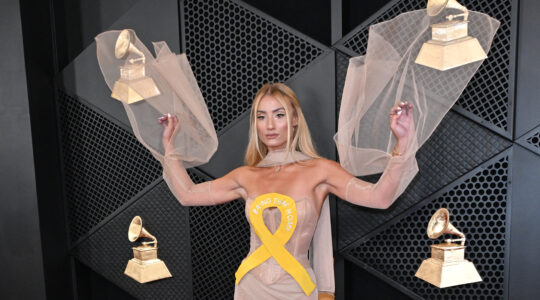TEL AVIV, Oct. 1 (JTA) — When Amiad Horowitz, 18, first came to Israel for Young Judaea’s Hamagshimim program, he was shocked to discover unorthodox views on Judaism and Israel among his non-Orthodox peers. Raised in an Orthodox home in Philadelphia and New Jersey, Horowitz was spending his first significant chunk of time away from home and — for the first time — was finding some of his core beliefs challenged. “My first response was to be very angry,” Horowitz recalls of one of an early incident when he locked ideological horns with his peers. “But in the end, nobody was changing his mind, so we just agreed not to talk about it anymore.” Hamagshimim offers post-high school students the opportunity to study, work on a kibbutz and volunteer in programs throughout Israel before beginning college in the United States. Bringing together Conservative, Orthodox, Reform and secular Jewish youngsters, the program is based in Jerusalem, where participants live together for three months before beginning projects elsewhere in Israel. Eventually he realized the program was an opportunity to become more worldly, Horowitz says. “The year course unshelters you, makes you more prepared for diversity, for what you see out there, for how things really work,” he says. More than anything else, perhaps, the Hamagshimim program is an opportunity for different kinds of young Jews to learn how to get along. Keith Berman, director of the year course and founder of Hamagshimim, which is sponsored by Hadassah, says uncomfortable encounters between youths is a key part of the program. “There are definitely tensions,” he says. “It’s not like everyone gets here and it’s a lovefest.” Learning how to live together is one of the program’s biggest challenges — and one of its points of pride. Young Judaea’s mission, Berman says, is to transform enmity between religious and secular Jews by encouraging program participants “to contribute their vision to Israel, instead of hating what is here.” Hamagshimim can drain the ideological swamps of secular-religious enmity in Israel the way Zionist pioneers drained the physical swamps of pre-state Palestine, he says. And Israelis are feeling Hamagshimim’s impact. “We are teaching Israelis what non-Orthodox Judaism is,” Berman says. Sharon Schoenfeld, director of Hamagshimim-Hadassah in Israel, agrees with Berman. “We are showing the Israeli community that something like this is possible,” she says. Schoenfeld is responsible for Hamagshimim’s aliyah support branch, which runs a private absorption center for English-speaking immigrants aged 20-35. Its Jerusalem headquarters is a mix of a Jewish community center and a home, providing living quarters for 30 residents and community activities for 2,000 members. While participants in the year program must abide by public Orthodox strictures — such as refraining from TV viewing in the public room on Shabbat — residents of the aliyah center have more latitude. “If a woman chooses to wear a bikini on our front lawn,” Schoenfeld offers as an example of something Orthodox rules of modesty might prohibit, “people need to accept it.” Yet both Hamagshimim projects share the same goals. Both provide the opportunity for people to learn about others and figure out how to live with different types of Jews — something that Israelis often have a difficult time doing in a country that increasingly seems fragmented into religious and secular enclaves. The only significant differences in approach between the two programs are that the aliyah center is geared toward adults and the year course is for teenagers. “I like learning about different Jewish expression,” says Becky Korman, 18, a Reconstructionist Jew from Montreal. “The part that has affected me the most has been my discussions with other students in the program who are modern Orthodox, and comparing the ways we have grown up.” Korman says she doesn’t mind adhering to certain Orthodox practices in the year course in order to make others feel comfortable. “I respect the fact that people have their traditions and need to practice Judaism as they see fit, so I’m not going to butt heads with someone who practices differently,” she says. Instead, she sees those differences as learning opportunities. For example, Korman says, “It’s so foreign to me that a woman couldn’t read from the Torah or lead a service,” in Orthodox practice. “I want to understand why modern Orthodox women practice this way.” The point, organizers say, is to foster a new kind of community, one marked by tolerance. Hamagshimim’s year course is “not liberal,” Berman says. It “is not ‘everyone does whatever they want,’ because we’re a community. If I’m keeping Shabbat, I don’t want to hear music or see a TV on Shabbat.” Before Rosh Hashanah this year, participants studied the meaning of the holiday and learned about diverse holiday traditions, including Sephardi ones. For Yom Kippur, program participants will be encouraged to “shul crawl,” visiting different area synagogues to get a broad view of how Judaism is practiced in Israel. “This is a great learning experience,” says Andrew Fretwell, 18, a secular Jew from New Jersey. “You get to see things from more than one perspective.”

Help ensure Jewish news remains accessible to all. Your donation to the Jewish Telegraphic Agency powers the trusted journalism that has connected Jewish communities worldwide for more than 100 years. With your help, JTA can continue to deliver vital news and insights. Donate today.





